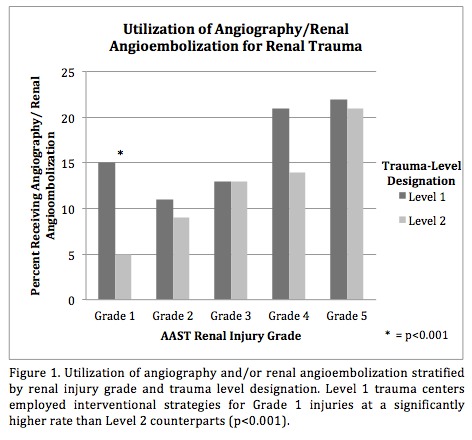|
Back to 2015 Joint Annual Meeting
High Utilization of Diagnostic Angiography and Renal Angioembolization for Low Grade Renal Trauma: Results from a Statewide Trauma Database
Ronak Gor1, Tianyu Li2, Jay Simhan3
1Einstein Healthcare Network, Philadelphia, PA;2Fox Chase Cancer Center, Philadelphia, PA;3Einstein Healthcare Network and Fox Chase Cancer Center, Philadelphia, PA
Introduction
Despite overwhelming evidence supporting conservative management for patients with low-grade traumatic renal injury, contemporary utilization of angioembolization in such patients is largely unknown. We evaluated usage of angiography and angioembolization for renal injuries and assessed differences in utilization based on trauma-level designation.
Materials&Methods
All renal injuries presenting at Level 1 and 2 trauma centers from 2000-2013 were identified from the Pennsylvania Trauma Systems Foundation database. Therapeutic intervention codes identified diagnostic angiography and/or renal angioembolization performance while renal injury was designated through AIS codes. Low-grade renal injuries were defined as ≤AAST grade 3. Performance of interventions was stratified by renal trauma grade and trauma-level designation.
Results
Of 3396 patients (median age 27, 76% male), there were 2361 (69.5%) low-grade and 1035 (30.5%) high-grade renal injuries identified. Diagnostic angiography and/or angioembolization was performed in 484 patients (14%) overall with fewer low-grade patients (277, 12%) receiving intervention than higher-grade injuries (207, 20%, p<0.001). Although rate of intervention was similar between Level 1 and 2 centers for patients with grade 2-5 injuries, significantly more Level 1 trauma patients received interventions with grade 1 injuries (15.1% vs. 5.4%, p<0.001).
Conclusions
Utilization of diagnostic angiography and/or renal angioembolization for low-grade renal injuries is surprisingly high. Factors accounting for the observed rates of utilization need to be further characterized.

Back to 2015 Joint Annual Meeting
|

